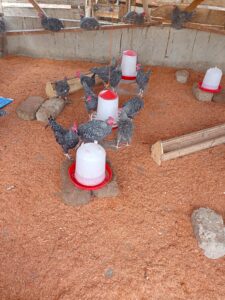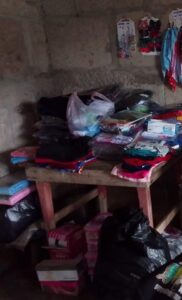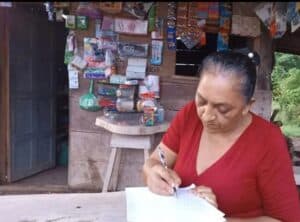New Production Techniques to Obtain Higher Yields

Joel takes a selfie with his corn
Joel’s parents used to live in a community named El Fajardo in a very remote area, but the community was evacuated and moved to another community named Never Oporta in the area of San Miguelito near to the main town due to the war situation in Nicaragua back in the 1980s. Mr. Joel was born in this new community (Never Oporta) and has lived there since then. He is now 37 years old, married and with two children (one boy and a girl).
He is a small-scale farmer and has a small business (grocery store) in his home that his wife operates. Joel completed three out of five years of high school, but he was not able to finish high school because he had to work to help his parents. He emigrated to the neighboring country Costa Rica where lived and worked for 5 years, saved up some money, and was able to return back to Nicaragua. He bought a piece of land of 2.5 manzanas (4.3 acres), where he is now currently working. On this land Mr. Joel is working exclusively with organic products. By following organic practices, he is able to achieve a good yield among all the crops he cultivates, and he likes that it’s both environmentally-friendly, and he doesn’t face the high costs of purchasing chemical inputs.
After a long time of work and efforts, Mr. Joel was able to get to a level where now he has been recognized by other farmers in the area, and he is a great example for other farmers to follow up and learn from. Now, Joel’s small plot of land is a model plot of using the Organic Agriculture method. He has cocoa, coconut, and fruit trees around the perimeter of his land, and uses the rest of the land to cultivate basic grains such as: rice, beans and corn.
Since all of the planting process has been done with organic products, this plot now is considered a chemical-free area and it is now in the process of being recognized and certified by the IPSA Institution (Institute for Protection and Agricultural Health), and by getting this certification he said, ¨I can be a farmer that will be know for being one of the first in my region to get this type of credit and recognition.¨
And, he continued ¨I consider myself a leader, since I am the one who organize most of the activities related to the benefits of our people in my community it doesn´t matter if it is for sports, religious and agricultural purposes. I play an important role so that other families can obtain the benefit of all programs that come to develop my community and as a consequence our quality of life.
Joel recounted his experiences working with Self-Help International, saying:
“I learned of Self – Help International and its Agriculture program thanks to the visit of his Program officer Rodolfo Hernandez, who came to my community Never Oporta to met me and shared all regarding this program, it technology, techniques, benefits and requirements that farmers need to fit to become members of this Agriculture Program.
“After having this conversation with the Self – Help technician, I was ready to share all this information with several farmers from my community, among them men and women, to become a large group who would received from Self-Help International all of those benefits, as we never had heard anything like what the technician was saying: that we could use less land and obtain the same amount of yield as if using larger piece of land. So, I was able to organize a large group of 28 farmers.
“Once the entire group was organized and trained with the benefits and characteristics of the INTA – Nutrader corn variety, and the double row planting technology, each one of the farmers received a donation of 4 pounds QPM corn, then was implemented a double row demonstration plot to learn the process of the technique to see futures results.
“My personal experience with the Double Row Technique was great since I have changed the old way of planting corn to the new one learned ¨The Double Row Technique¨ taught by the Self – Help International technician, and, as a result I obtained higher yields. What I liked the most about the variety of this type of corn QPM, INTA – Nutrader is a characteristic that all small producers dreams to see some day, which is: to see the ear all covered not showing its tip, which means that the coverage prevents the ear from rotting when there is a lot of rain, which is mainly our case conditions, as in this area of the country we have more rain than other places. And, thanks to this new condition our corn will survive those heavy and permanent rains. In addition to the size of the ear, the height of the plant makes it easy to harvest.

I took into account all the recommendations that the technician gave during the training, and out of the 4 pounds of corn I received from Self-Help International, I obtained a yield of 3 quintales (5.4 bushels). This allows me to keep reproducing this type of corn because from those three quintales, I will save enough seed to plant one manzana of corn. We usually use 60 pounds of corn to plant one manzana, and the rest of the corn will be used for our own consumption. My family and I, like all of the Nicaraguan people, survive mainly on corn products such as: tortillas, cereals, nacatamales, tamales, chichas, ect all made with green and dry corn. I am satisfied with this yield result since I considered that if with four pounds of corn I obtained three quintals (qqs) of corn, then if I plant a manzana of corn I would obtain 48 qq´s of corn. This is an estimate, and if this really happens, it will be as great as we usually obtain from one manzana just 20 qq´s using the old way of planting. So, if I get 48 qq´s that mean that will be double or it could be even more. So, my next purpose is to plant one manzana of corn in the next season, following the new technique and all of the recommendations of the technician, and I will let you know my experience.
We (the technician and I) have monitored the other members of the group and they shared with us that they are all satisfied with the variety of corn and the yields they obtained from it.
In addition to the QPM corn, Self – Help International also donated biofortified seeds of rice and beans, but we will see the yields of these next year. I am grateful for Self – Help International since in my community 90% of its people are farmers dedicated to working the land and with this great support we will be able to grow, development our skills through new technologies and techniques that are in favor of the development of rural communities.
I am grateful to the organization for having provided this donation for the most vulnerable families in the region and I urge other farmers to keep reproducing the seeds that Self – Help International have donated to us, since this is a benefit that not everyone can obtain, therefore the seed must be saved to continue to keep our foods rich in protein and minerals that help us maintain our healthy body conditions.
Without further words, I want to say goodbye but not before thanking all of your great support and donations to us and we hope to keep working with you to continue improving our way of working the land with new techniques and technologies that help develop our yields and quality of life. In addition to this, we also hope that you will support other farmers so that they can continue to grow and improve their land in following practices of conservation agriculture.

 Next Post
Next Post


